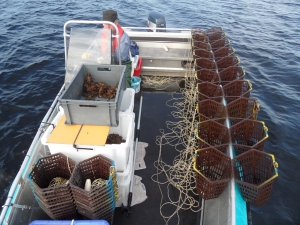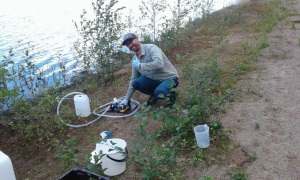CRAYFISH AS A BIOINDICATOR
The effects of a large pulp&paper mill wastewater on lake Saimaa water quality and aquatic ecosystem are monitored as part of environmental impact assessment, with a local signal crayfish population as one of the bioindicators. The monitoring is based on both the overall development of signal crayfish catch (cray fisher person’s reports on their annual catch) and detailed investigation of selected test catches (3 test sites, 2 catch sets each, 4 times during crayfish season). Based on size distribution, a number of crayfish been caught and their health status conclusions on the possible straight effects of a pulp&paper mill on the local crayfish stocks and indirect impacts via water quality and whole aquatic ecosystem changes are assessed.
The project was initiated in 2009 and carries on till the foreseeable future. The project includes collaboration with South Karelian Fishery Center and local cray fisher persons. The project is funded from a pulp&paper mill’s fishery impact monitoring fees.
Project key personnel includes Mr. Vesa Tiitinen (South Karelian Fishery Center) and Dr. Japo Jussila (UEF). Dr. Jussila coordinates crayfisheries monitoring, analyses results, and prepares required reports.
Links: www.ekkalatalouskeskus.fi
THE EFFECTS OF TERRAFAME MINE WASTEWATER ON LAKE NUASJÄRVI CRAYFISH STOCK
Since 2015 Terrafame Talvivaara mine has been discharging wastewaters by a pipeline into lake Nuasjärvi bypassing smaller water bodies downstream of the mine. The environmental impact monitoring of Terrafame Talvivaara mine includes evaluating potential effects of the mine waste waters on lake Nuasjärvi crayfish stock. The project outsourced by the local fishing rights owners, been represented by the Sotkamo Fisheries District. The evaluation is based on published studies and environmental reports on the Terrafame Talvivaara mine’s impact on local aquatic ecosystems and known quality of the wastewater been discharged into lake Nuasjärvi. Besides, local fishing rights owners and fisherpersons are interviewed, and also test trappings could take place.
The project duration is 2019 – 2021.
The project key personnel includes Mr. Anssi Härkönen (Sotkamo Fisheries District and Kainuu Fisheries Center) sekä Dr. Japo Jussila (UEF, project manager). Dr. Jussila’s role is to study background information, collect up to date information on both Terrafame Talvivaara mine’s wastewater and lake Nuasjärvi crayfish stock, analyse the data and prepare a report.
Links: https://kalallakainuussa.fi/kumppanit/kainuun-kalatalouskeskus/
ENVIRONMENTAL DNA AS MEANS TO ASSIST CRAYFISHERIES MANAGEMENT
There has been intensive eDNA method R&D in Fennoscandia to apply the method to satisfy the needs of crayfisheries management for the decade. The University of Eastern Finland has initiated this R&D in collaboration with the Norwegian Veterinary Institute and Oslo University. Currently, the eDNA methods developed are being applied to better suit Finnish requirements in cooperation with the University of Jyväskylä, Natural Resources Institute Finland, and South Karelian Fishery Center. We aim to introduce the fine-tuned eDNA method as a routine tool in assessing wild crayfish stocks (namely the presence of noble crayfish and signal crayfish) and in tracing crayfish plague. An essential aspect of the project is to enhance conservation attempts of the native noble crayfish stocks.
The project is carried out until 2021.
The project key workers include Dr. Japo Jussila (UEF; eDNA ja crayfish expert), Mr. Vesa Tiitinen (South Karelian Fishery Center), Dr. Timo Ruokonen (Natural Resources Institute Finland) and Mr. Mikko Mäkinen (the University of Jyväskyla, project manager). Dr. Jussila’s role is to supervise and participate in field work and eDNA R&D, supervise molecular analyses, and participate in the report’s preparations.
Relevant links with more information: www.ekkalatalouskeskus.fi and Department of Biological and Environmental Science (JyU)